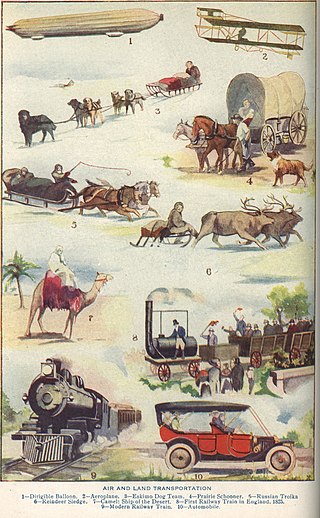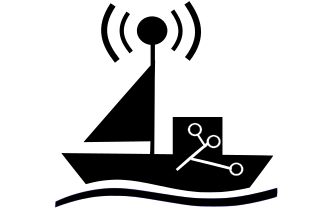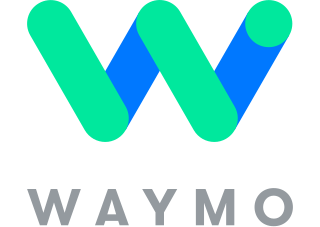Related Research Articles

This is a timeline of transportation technology and technological developments in the culture of transportation.

A self-driving car, also known as an autonomous car, driver-less car, or robotic car (robo-car), is a car that is capable of traveling without human input. Self-driving cars use sensors to perceive their surroundings, such as optical and thermographic cameras, radar, lidar, ultrasound/sonar, GPS, odometry and inertial measurement units. Control systems interpret sensory information to create a three-dimensional model of the surroundings. Based on the model, the car identifies appropriate navigation paths, and strategies for managing traffic controls and obstacles.

Teleoperation indicates operation of a system or machine at a distance. It is similar in meaning to the phrase "remote control" but is usually encountered in research, academia and technology. It is most commonly associated with robotics and mobile robots but can be applied to a whole range of circumstances in which a device or machine is operated by a person from a distance.

Vehicular automation involves the use of mechatronics, artificial intelligence, and multi-agent systems to assist the operator of a vehicle. These features and the vehicles employing them may be labeled as intelligent or smart. A vehicle using automation for difficult tasks, especially navigation, to ease but not entirely replace human input, may be referred to as semi-autonomous, whereas a vehicle relying solely on automation is called robotic or autonomous. Both of these types are instantiated in today's various self-driving cars, unmanned surface vehicles, autonomous trains, advanced airliner autopilots, drone aircraft, and planetary rovers, as well as guided rockets and missiles. After the invention of the integrated circuit, the sophistication of automation technology increased. Manufacturers and researchers subsequently added a variety of automated functions to automobiles and other vehicles. The technology involved in implementing autonomous vehicles is very expansive, ranging from technological improvements in the vehicle itself to the environment and objects around the vehicle. As the use of automated vehicles increases, they are becoming more influential in human lives. Although automated vehicles bring various benefits, they also come with various concerns. Also, there are still technological challenges that need to be overcome in order to make vehicular automation robust and scalable.

An unmanned surface vehicle (USV), also known as unmanned surface vessel, autonomous surface vehicle (ASV) in some cases, uncrewed surface vessel (USV), or, colloquially, a drone ship, or robot boat, is a boat or ship that operates on the surface of the water without a crew. USVs operate with various levels of autonomy, from remote control to fully autonomous.

Daniela L. Rus is a roboticist and computer scientist, Director of the MIT Computer Science and Artificial Intelligence Laboratory (CSAIL), and the Andrew and Erna Viterbi Professor in the Department of Electrical Engineering and Computer Science (EECS) at the Massachusetts Institute of Technology.

Waymo LLC, formerly known as the Google Self-Driving Car Project, is an American autonomous driving technology company headquartered in Mountain View, California. It is a subsidiary of Alphabet Inc., the parent company of Google.

Mobileye Global Inc. is a company developing autonomous driving technologies and advanced driver-assistance systems (ADAS) including cameras, computer chips and software. Mobileye was acquired by Intel in 2017 and went public again in 2022. Mobileye is based in Jerusalem, Israel, and also has sales and marketing offices in Midtown, Manhattan, US; Shanghai, China; Tokyo, Japan; and Düsseldorf, Germany.

Experiments have been conducted on self-driving cars since 1939; promising trials took place in the 1950s and work has proceeded since then. The first self-sufficient and truly autonomous cars appeared in the 1980s, with Carnegie Mellon University's Navlab and ALV projects in 1984 and Mercedes-Benz and Bundeswehr University Munich's Eureka Prometheus Project in 1987. Since then, numerous major companies and research organizations have developed working autonomous vehicles including Mercedes-Benz, General Motors, Continental Automotive Systems, Autoliv Inc., Bosch, Nissan, Toyota, Audi, Volvo, Vislab from University of Parma, Oxford University and Google. In July 2013, Vislab demonstrated BRAiVE, a vehicle that moved autonomously on a mixed traffic route open to public traffic.
A robotaxi, also known as robo-raxi, self-driving taxi or driverless taxi, is an autonomous car operated for a ridesharing company.

NuTonomy was an MIT spin-off technology startup company that made software to build self-driving cars and autonomous mobile robots. The company was founded in 2013. In August 2016, it launched its robo-taxi service in Singapore. In October 2017, Delphi Automotive purchased the company, which then became part of the Motional autonomous driving joint venture between Aptiv and Hyundai Motor Group.

Argo AI was an autonomous driving technology company headquartered in Pittsburgh, Pennsylvania. The company was co-founded in 2016 by Bryan Salesky and Peter Rander, veterans of the Google and Uber automated driving programs. Argo AI was an independent company that built software, hardware, maps, and cloud-support infrastructure to power self-driving vehicles. Argo was mostly backed by Ford Motor Co. (2017) and the Volkswagen Group (2020).
Torc Robotics (Torc), an independent subsidiary of Daimler Truck, is an American autonomous truck company headquartered in Blacksburg, Virginia, with operations in Albuquerque, New Mexico; Austin, Texas; and Stuttgart, Germany. Torc is testing autonomous trucks in Virginia, New Mexico, and Texas and is taking a pure play approach to commercialization – focusing at first on one platform in one region.
Oxbotica is an autonomous vehicle software company, headquartered in Oxfordshire, England, and founded by Paul Newman and Ingmar Posner.
Cruise LLC is an American self-driving car company headquartered in San Francisco, California. Founded in 2013 by Kyle Vogt and Dan Kan, Cruise tests and develops autonomous car technology. The company is a largely-autonomous subsidiary of General Motors.
A self-driving truck, also known as an autonomous truck, or robo-truck is an application of self-driving car designed to transport cargo without requiring a human driver. Many companies are testing self-driving semi trucks.

Buffalo Automation is an artificial intelligence (AI) startup that develops autonomous navigation technology for commercial ships, recreational boats, and water taxis with the goal to improve maritime safety. It is a private company based in Buffalo, New York. Thiru Vikram is the CEO of the company.
Drive.ai, a subsidiary of Apple Inc., is an American technology company headquartered in Mountain View, California that uses artificial intelligence to make self-driving systems for cars. It has demonstrated a vehicle driving autonomously with a safety driver only in the passenger seat. To date, the company has raised approximately $77 million in funding. Drive.ai's technology can be modified to turn a vehicle autonomous.

Yandex self-driving car is a autonomous car project of the Russian-based technology company Yandex. The first driverless prototype launched in May 2017. As of 2018, functional service was launched in Russia with prototypes also being tested in Israel and the United States. In 2019, Yandex revealed autonomous delivery robots based on the same technology stack as the company's self-driving cars. Since 2020, autonomous robots have been delivering food, groceries and parcels in Russia and the USA. In 2020, the self-driving project was spun-off into a standalone company under the name of Yandex Self-Driving Group.
DeepRoute.ai is a self-driving technology company headquartered in Shenzhen and Fremont, California and is focused on advancing urban logistics and popularizing robotaxis.
References
- ↑ "Roboats ahoy: Amsterdam canals picked to test self-driving fleet". Reuters. 2017-09-19. Retrieved 2017-05-23.
- ↑ Condliffe, Jamie. "Fleets of robotic boats are getting ready to set sail". MIT Technology Review. Retrieved 2017-05-23.
- ↑ "Roboat Q&A". AMS Institute. 2016-09-18. Archived from the original on 2016-09-25. Retrieved 2017-05-23.
- ↑ "Roboat / MIT Senseable City Lab". senseable.mit.edu. Retrieved 2017-05-23.
- ↑ Monks, Kieron. "Self-driving boats unleashed in Amsterdam". CNN. Retrieved 2017-05-23.
- ↑ Lott-Lavigna, Ruby. "Self-driving boats will soon be setting sail". WIRED UK. Retrieved 2017-05-23.
- ↑ "Amsterdam to get driverless 'roboats' on canals". Sky News. Retrieved 2017-05-23.
- ↑ "Get ready, self-driving boats are coming, too". USA TODAY. Retrieved 2017-05-23.
- ↑ "Zelfvarende boten in Amsterdamse grachten". nrc.nl (in Dutch). Retrieved 2017-05-23.
- ↑ "Self-Driving Robot Boats, Coming Soon to Amsterdam". CityLab. Retrieved 2017-05-23.
- ↑ "Self-driving boats will be tested on Amsterdam's canals next year". The Verge. 2016-09-19. Retrieved 2017-05-23.
- ↑ Lavars, Nick (2021-10-28). "MIT deploys first full-scale autonomous Roboat on canals of Amsterdam". New Atlas. Retrieved 2021-10-29.
{{cite web}}: CS1 maint: url-status (link) - ↑ Gordon, Rachel. "Self-driving Roboats set sail in Amsterdam canals". Massachusetts Institute of Technology . Retrieved 15 November 2021.